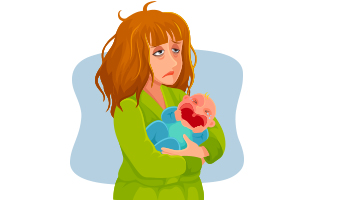Approximately 20% of all young babies suffer from infant colic – an unexplainable condition that causes excessive crying in an otherwise healthy baby. Crying comes with the territory. But for some; the reality can be a lot more intense.
There is no known cause and few solutions to infantile colic
Research Studies
There are many studies that have shown Chiropractic care can significantly reduce periods of crying in colicky infants. Babies who did receive chiropractic care cried an average of 2 hours less each day after ten days of care.
Video Transcript
When you’re making the exciting preparations to meet your new baby, most parents are realistic about the fact there will be some tears along the way. Crying comes with the territory. But for some; the reality can be a lot more intense.
10-30% of all young babies suffer from infant colic1-3 – which is an unexplainable condition that causes excessive crying in an otherwise healthy baby. There is no known cause and few solutions. Being unable to soothe your inconsolable baby can obviously be quite distressing.
Aside from being stressful, tiring – even heart-breaking for parents – infant colic can also be a cost burden to our society in terms of healthcare resources. The good news is there are some things that you can do to soothe your baby.
There are many studies that have shown Chiropractic care can significantly reduce periods of crying in colicky infants.1 Let’s take a closer look at one of these studies.4 Conducted in the UK, in 2007, the researchers wanted to find out how effective chiropractic care was for babies who were experiencing unexplained crying.
104 babies, 8 weeks old and younger, were able to participate in this study between October 2007 and November 2009, at a chiropractic teaching clinic. They were randomized into 3 groups.
The first group of babies was given chiropractic care; and their parents were aware that this was happening. The second group also received chiropractic care, but their parents didn’t know whether their baby was receiving chiropractic care or the control intervention.
And the third group didn’t get checked by a chiropractor and instead they received the control intervention. These parents also didn’t know whether their baby was receiving chiropractic care or the control.
Over a ten day period all parents completed daily crying diaries, documenting their baby’s behaviour. The first and second group of babies who were receiving chiropractic care were individually examined and given gentle spinal adjustments where required, as often as needed.
If we take a look at this graph – this side is the average change in crying time, measured in hours; and down here we have the number of days – so 10 all up. We can see here that the babies who didn’t receive care still saw a reduction of crying time by about an hour or less.
But now look at the babies who did receive chiropractic care – they’ve fared significantly better with up to 3 hours less crying in some cases. The researchers found that both groups of babies who received chiropractic care responded equally well.
We can see here that babies who did receive chiropractic care cried an average of 2 hours less each day after ten days of care. This is a significant reduction in crying – especially for the potentially frazzled parents.
Interestingly, it didn’t make a difference whether the parents knew that their baby was receiving chiropractic care or the control. This confirms previous studies that have also shown babies with colic responding well to chiropractic care. It means that the child’s improvement is probably due to the chiropractic itself and not parent bias or parent placebo effect.
This study found that excessively crying babies were at least 5 times as likely to cry significantly less if they received chiropractic care compared to not receiving care. So it’s very likely that chiropractic care really does help babies who are suffering from colic. The chiropractic care that was given to the babies in this particular study was performed by chiropractic students under the supervision of fully qualified chiropractors; and their care had some remarkable results and made a real difference to the families involved. So imagine what a fully qualified and experienced chiropractor could do to help you and your family?
References
- Alcantara J, Alcantara JD, Alcantara J. The chiropractic care of infants with colic: a systematic review of the literature. Explore (NY) 2011;7(3):168-74. doi: 10.1016/j.explore.2011.02.0010.1016/j.explore.2011.02.002 [published Online First: 2011/05/17]
- Dobson D, Lucassen PL, Miller JJ, et al. Manipulative therapies for infantile colic. Cochrane Database Syst Rev 2012;12:CD004796. doi: 10.1002/14651858.CD004796.pub2 [published Online First: 2012/12/14]
- Johnson JD, Cocker K, Chang E. Infantile Colic: Recognition and Treatment. Am Fam Physician 2015;92(7):577-82. [published Online First: 2015/10/09]
- Ellwood J, Draper-Rodi J, Carnes D. Comparison of common interventions for the treatment of infantile colic: a systematic review of reviews and guidelines. BMJ open 2020;10(2):e035405. doi: 10.1136/bmjopen-2019-035405
- Miller JE, Newell D, Bolton JE. Efficacy of chiropractic manual therapy on infant colic: a pragmatic single-blind, randomized controlled trial. J Manipulative Physiol Ther 2012;35(8):600-7. doi: 10.1016/j.jmpt.2012.09.010 [published Online First: 2012/11/20]

